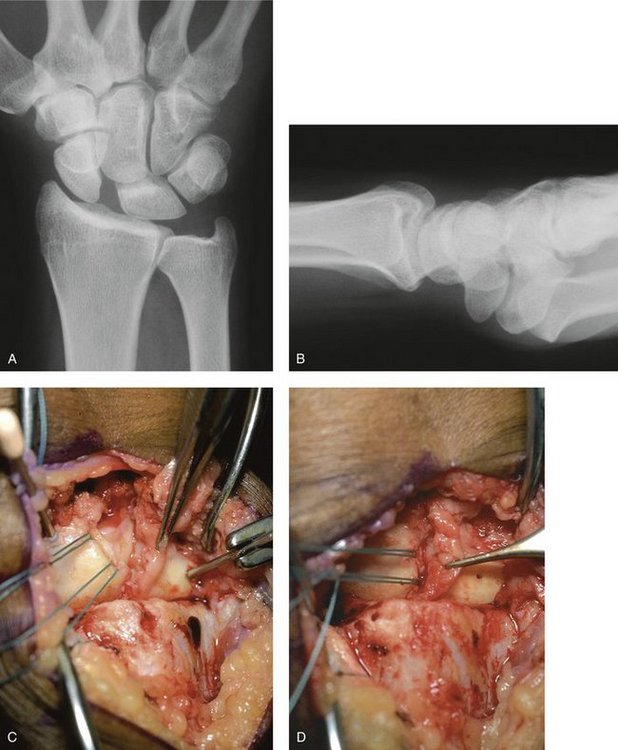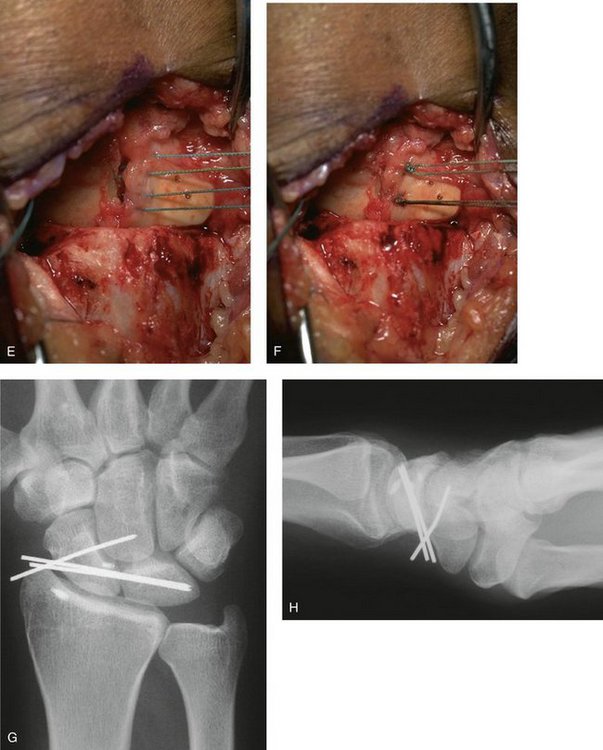CHAPTER 46 Open Scapholunate Ligament Repair
Rationale
Dissociation between the carpal scaphoid and lunate is the most common pattern of wrist instability.1–3 Because scapholunate dissociation leads to progressive degenerative arthritis of the wrist,2,4,5 reduction and internal fixation is the preferred method of treatment, particularly in the acute setting.6–10 Owing to the small surface area and the high loads placed on the repaired ligament, a variety of capsular reconstructions (capsulodeses) have been described to augment scapholunate ligament repair. These procedures use the dorsal capsule or the dorsal radiocarpal and dorsal intercarpal ligaments, or both the capsule and ligaments, to help keep the scaphoid out of pathological flexion and the lunate out of excessive extension (Fig. 46-1).
Indications
Indications for direct ligament repair and capsulodesis include a documented dissociation with an adequate ligament still available for repair at the time of surgery, a reducible scapholunate relationship, and the absence of degenerative changes within the carpus. Although these procedures are best when performed early, some data suggest that the results do not depend on the interval between injury and surgical repair.11 Additional reconstructive options to treat scapholunate dissociation are discussed in subsequent chapters, including using the flexor carpi radialis tendon as a tenodesis and a screw, rather than smooth pins, to maintain the scaphoid and lunate relationship. Partial wrist fusions, such as between the scaphoid, trapezium, and trapezoid (scaphotrapeziotrapezoid fusion) or between the scaphoid and capitate (scaphocapitate fusion), which were previously popular are falling out of favor for scapholunate dissociation.
Contraindications
The main contraindication to direct ligament repair of a scapholunate dissociation is arthritic changes within the carpus. When the scaphoid and lunate become dissociated, a progressive pattern of wrist arthritis ensues. Wear begins at the radial styloid and progresses to involve the entire radioscaphoid articulation and then the midcarpal joint. The degree of arthrosis is not always apparent on plain radiographs of the wrist (Fig. 46-2). When degenerative changes are present, most notably in the scaphoid fossa of the radius, alternative salvage options are required, such as a proximal row carpectomy or a midcarpal (four-bone) fusion.
Surgical Technique
The procedure of direct scapholunate ligament repair with dorsal capsulodesis begins with a dorsal longitudinal incision centered over the scapholunate interval. The dorsal retinaculum is divided in line with the third compartment, and the extensor pollicis longus is retracted radially. The posterior interosseous nerve can be found on the radial floor of the fourth dorsal compartment. A neurectomy is performed because this nerve partly innervates the scapholunate ligament.12 The fourth dorsal compartment is subperiosteally reflected ulnarly to aid in the exposure, but its subsheath is not violated.
The wrist joint is exposed through a straight capsular incision. Care is taken not to elevate the radial capsular flap off of the radius. Alternatively, the radial flap can be elevated in a subperiosteal fashion, but this would need to be secured later to the dorsal aspect of the distal radius to complete the capsulodesis. The dorsal and membranous portions of the scapholunate interosseous ligament are evaluated. The ligament is typically torn off of the scaphoid remaining attached to the lunate. It can avulse off of the lunate, however, and remain attached to the scaphoid. Lastly, one occasionally observes central attenuation within the ligament proper. If there is little or no interosseous ligament remaining for repair, alternative surgical options can be considered.13–17
The dorsal aspect of the proximal pole of the scaphoid and corresponding scaphoid facet of the distal radius are inspected for degenerative changes. As noted previously, if significant degeneration exists, one needs to consider a salvage-type operation.5,18–20 Advanced radioscaphoid arthritis is a contraindication to direct ligament repair. If only slight pointing at the radial styloid exists, however, a limited styloidectomy can be done. Care is taken to protect the radial capsule during subperiosteal dissection for the styloidectomy.
Kirschner wires are inserted in a dorsopalmar direction into the scaphoid and lunate to be used as joysticks. Because significant force may be required to reduce the diastasis, 0.062-inch wires are typically used for this purpose. The scaphoid wire is placed in a slightly distal to proximal direction; the lunate pin is angled slightly from proximal to distal to facilitate subsequent rotation of the bones. A narrow trough is created next along the dorsal lunate or scaphoid with a bur or fine rongeur at the site of detachment. Although the repair was originally described using drill holes and Keith needles, newer miniature bone anchors can be used to aid in the repair. With the joint opened, the anchors can be placed (Fig. 46-3). It is sometimes easier to place the anchor sutures into the ligament in their anatomical position before the final fixation. This is especially true for the more proximal sutures, which may be difficult to work with when the bones are reduced, and this area rotates beneath the dorsal rim of the radius.



FIGURE 46-3 A and B, Posteroanterior (A) and lateral (B) radiographs of a patient with a scapholunate dissociation. C, Intraoperative photograph depicting the bone anchors that have been placed into the scaphoid at the site of ligament avulsion. Note the Kirschner wires in the scaphoid and lunate being used as joysticks. D, The scapholunate dissociation has been reduced and secured with percutaneous Kirschner wires placed from the scaphoid into the lunate, and from the scaphoid into the capitate. The ligament is seen in the forceps. E and F, Sutures have been passed into the ligament (E









